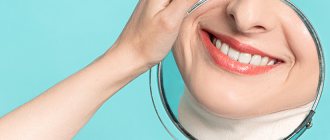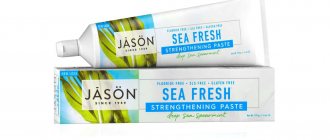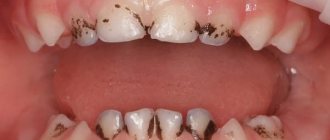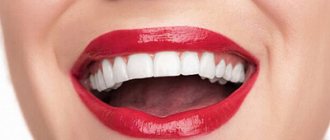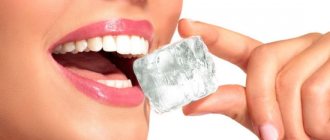One of the most popular services in cosmetic dentistry today is teeth whitening. In no way related to medicine, nevertheless, it is in great demand, because... in the minds of many of us, it is white (light) teeth that are an indicator of their health, as well as the high social status of their owner.
As I wrote earlier, such ideas were not always dogma, and how long such a fashion will last is unknown, but today it is so. I myself am neither a supporter nor an opponent of this procedure, and therefore I will try to talk about whitening as objectively and unbiasedly as possible. Moreover, I will do this in the form of questions and answers (i.e., a kind of FAQ on teeth whitening).
What is whitening and how does it differ from professional cleaning?
Very often patients say: “I want to whiten my teeth because... they have stains from coffee and cigarettes.” At the same time, they confuse 2 different procedures - teeth cleaning and teeth whitening. If brown plaque has accumulated on your teeth or stones have formed, then you need professional teeth cleaning, which is carried out with ultrasound, sandblasting (air-flow) or simply with a brush and a special professional abrasive paste. In this case, the dentist simply removes plaque from the surface of the teeth without changing their natural color. Although they become lighter, this is not bleaching. The whitening procedure involves the use of a strong oxidizing agent to lighten the actual tooth tissue. Hydrogen peroxide or carbamide peroxide, familiar to any unnatural blonde, is used as an oxidizing agent (it is approximately 2 times weaker than hydrogen peroxide). Penetrating into the internal structures of the tooth, the released active oxygen destroys the molecules of natural pigments, which leads to the fact that the tooth becomes lighter.
This is what plaque on teeth looks like, resulting from the abuse of cigarettes, coffee, and strong tea. It can be removed by professional cleaning, which has nothing to do with bleaching.
Review of the best ways to whiten and clean dentures – at home and in the dental clinic
Article navigation
- Why do you need care?
- What happens if there is no care
- Basic storage rules
- Cleaning methods
- Cleansing and whitening at home
- - Toothbrush
- – special pastes and gels
- - tablets and solutions
- - ultrasonic bath
- Professional cleansing in the clinic
- Is it worth using folk remedies?
- - citrus juices and citric acid
- - baking soda and hydrogen peroxide
- Side effects due to inappropriate medications
- How to maintain the aesthetics of your smile
- User Questions
Question to a specialist
Dentures are placed in order to restore the aesthetics and chewing function of the dental system. But active or improper use of orthopedic structures can lead to the appearance of stains and plaque on them. Can dentures be whitened? Cleaning artificial “jaws” – plastic, acrylic, etc. – to their original appearance is quite problematic, but possible. Next, we will tell you how to clean them from tartar, blackness and yellowness, pigmentation, and what is better to use - folk remedies at home or still turn to professionals in dentistry.
What types of whitening are there? Which whitening method is more effective?
If we talk about really effective whitening, then there are only two types. Office and home. I repeat once again that the essence is the same everywhere. What's the difference then? Office work, as you might guess, is carried out in the dentist’s office. It is produced by gels with a high concentration of bleaching agent (usually 35-38% hydrogen peroxide). You cannot do procedures with such concentrations yourself, because contact of the gel of such concentrations with the mucous membrane causes severe burns. The doctor uses numerous means of protection so that only the teeth are whitened, and not the tongue or lips. Some whitening systems (Zoom, LumaCool, etc.) involve activating the gel with a special lamp for a faster and more effective procedure. Some are simply applied to the teeth and work without any additional activation by light (Opalescence, Bleach n' Smile , etc.) In any case, the procedure takes about 1-1.5 hours and the result can be seen almost immediately. Especially in systems with light activation of the gel.
This photo shows the process of in-office whitening with the Opalescence XtraBoost system, which I prefer to use in my practice. The green arrows indicate the actual whitening gel (38% hydrogen peroxide), the blue arrows indicate the protective coating of the gums (the so-called “liquid dam”), the black arrows indicate a temporary plastic crown, which does not whiten and will be replaced with a permanent one after completing the whitening course.
Home whitening involves the patient performing the procedure independently at home. BUT! Under the supervision of a doctor exclusively! Ideally, you come to the doctor, in 1-2 days they make a special plastic individual mouthguard for your teeth, give you instructions on what gel, what concentration and according to what scheme is best to use in your case. And then at home you do everything exactly as the doctor ordered. Results can usually be seen within a couple of weeks. Exactly the same result as with the cabinet version.
The custom tray is filled with whitening gel and placed over the teeth. Mouthguard wearing patterns vary and must be selected individually by the dentist.
Let's summarize the pros and cons of teeth whitening options . In-office treatment is faster, but it is usually more expensive and is often associated with the appearance of unpleasant sensitivity, both during the procedure and for some time after it. Home whitening will give a similar result over a longer period, but it is cheaper and, as a rule, does not cause discomfort in the form of increased tooth sensitivity. In cases where the result is not required right now (unexpected wedding, urgent important date, etc.), it is better to choose home whitening. But if you are not confident in your accuracy, you don’t want to spend a long and tedious time remembering all the rules and following all the recommendations, prefer a less complicated office option.
If you suddenly have an important event in your life that you need to approach with a dazzling smile, then in-office whitening is your choice.
What happens if there is no care
Installing a new and beautiful denture can give a person the deceptive feeling that the artificial structure will always be like this and there is no need to take special care of it. But this opinion is wrong, because the characteristics of the materials (for example, the presence of micropores on the surface) and the lack of regular cleaning and disinfection are a direct path to the appearance of age spots and the formation of tartar on the teeth. Moreover, it is impossible to remove the stone even with a special brush and paste at home. The result will be the following manifestations:
OPERATIVE PROSTHETICS WITH ACRYLIC PROSTHETICS - from RUR 180,000.
Re-prosthetics with an acrylic bridge on a metal frame (all included) up to 12 units.
Save RUR 30,000. Call now or request a call
- decreased smile aesthetics,
- stomatitis due to the influence of microbes on the mucous membranes,
- destruction of supporting teeth: caries occurs due to cariogenic bacteria,
- risk of breakage of the prosthetic base: stone build-ups can reduce the strength properties of materials, especially elastic ones - plastics, nylon, acrylic,
- penetration of harmful microbes into the stomach and intestines: inflammatory processes occur, beneficial substances are less absorbed, and the body’s immune defense weakens.
Will my teeth have sensitivity after the whitening procedure?
I began to partially answer this question in the previous paragraph. In each case, the manifestation of hypersensitivity during and after the procedure cannot be predicted; everything is quite individual. Generally speaking, the appearance of increased sensitivity of bleached teeth to one degree or another manifests itself after any whitening method. The faster the procedure occurs, the higher the concentration of the whitening gel, the stronger and longer the discomfort. Therefore, according to the degree of severity of unpleasant sensations, we can rank the procedure options as follows: in-office with the use of activating lamps gives complications more often and the intensity of unpleasant sensations is higher, in-office without activating the gel with light - less, home - least often, up to complete absence. One way or another, there is no need to be afraid of this. Usually, however, the sensitivity is not very intense and lasts a maximum of a few days. In addition, there are special products to reduce tooth sensitivity that you can use during this period. In some whitening systems, they come complete with all consumables for the procedure, and are given to you by the doctor.
Is teeth whitening a harmful procedure?
As one medieval doctor said, “All poison is just a matter of dose.” The same can be said here. It is no secret that there is absolutely no benefit from bleaching in the medical sense. But there will be no harm from a competently carried out procedure. Suffice it to say that in the USA the bleaching procedure is very popular, and is generally equated to hair lightening, because... they even carry it out in shopping centers, not seeing any sedition in it. Therefore, if you really want to, bleach it. Only under the supervision of a doctor. In addition, the teeth on which the gel will be applied must be healthy, they should not have leaky fillings or caries. The dentist should check all this before you go into all serious troubles. He should also choose the best whitening method specifically for you and your teeth . Suggest the correct scheme for using products for home use, explain the features of dental care, etc. and so on. In general, conduct a full briefing and control. Only in this case the procedure will be as safe as possible and will bring nothing but a refreshed, white-toothed smile (if you are dreaming of it).
Teeth whitening looks so unpretentious and mundane in many shopping centers in the United States. While your wife is replenishing her wardrobe, and her beloved mother-in-law is replenishing her refrigerator, you can lie down and benefit your appearance.
Why do you need care?
In short, caring for removable orthopedic structures is necessary so that they maintain an attractive appearance and functionality. And also so that a person can communicate with others without hesitation, without worrying about bad breath. High-quality care is required to maintain normal microflora in the oral cavity, i.e. so that harmful microorganisms do not prevail over neutral and beneficial ones. Timely removal of soft and hard plaque also eliminates a potential source of infection, because they are inhabited by a large number of pathogenic bacteria. That is, adequate care protects against inflammation in the oral cavity and infections. And what will happen in his absence, we will tell further.
How effective and harmful are whitening toothpastes?
Here it must be said that the vast majority of so-called whitening pastes are actually not capable of whitening anything, because... they simply lack an oxidizing agent. So this is a kind of advertising ploy by the manufacturers. But what they do have is a higher content of abrasive substances for more effective plaque removal. You should not use such toothpastes regularly; it can cause serious harm to your teeth. At a minimum, this may threaten the appearance of increased sensitivity of teeth , and at a maximum, the appearance of non-carious lesions (mainly wedge-shaped defects). They can be used only temporarily (no more than one medium tube is used up) and it is advisable to alternate it with regular toothpaste. It is needed primarily by heavy smokers and coffee lovers. If you are not one of them, then you should not turn your attention to “whitening” toothpastes. In some rare cases, whitening toothpastes do contain small amounts of a bleaching agent. And such a paste really has the right to be called “whitening.” They are sold more often in pharmacies and are much more expensive than regular pastes. But even with regular use, you should not count on a noticeable effect from their isolated use. Concentrations are too low. As a rule, they are used for the period while the home whitening process is in progress to enhance and maintain the effect.
Here you can also talk about other “pharmacy” products for teeth whitening – various varnishes, strips, etc. All of these are very ineffective drugs for the same reason - a low concentration of the bleaching agent. To feel the results from them, you need to have a very high power of self-hypnosis. So it's just wasted money.
What effective folk whitening remedies exist? How to whiten teeth at home?
This question could be answered briefly: there are no effective traditional methods of teeth whitening . And I would like to warn against the thoughtless use of improvised means in order to save money. Very often this backfires. It is strictly forbidden to use soda, tooth powders, lemon, activated carbon, etc. to brighten your smile. in different combinations. I personally once had a patient who spent a considerable amount of time brushing her teeth with a mixture of baking soda and lemon juice. When she came to me, I learned for the first time what enamel erosion looks like. At that time I had not yet photographed clinical cases, but it looked something like this.
How do you like this “whitening”? Instead of beautiful teeth, they were irreparably damaged and their restoration cost her a lot of money. As usually happens, thoughtless savings turned into even greater expenses.
I also heard a story from colleagues about how one of the patients whitened his teeth with “Toilet Duck”, because the bottle said “safe for enamel.” Well, what else can you say?
to whiten your teeth on your own online . Most of them are just a waste of time. And some are simply harmful. So, in pursuit of beauty, do not lose your sanity, otherwise you risk losing your teeth. Ultimately, if you need to post your photo on a social network or forum, you can whiten your teeth using Photoshop (as they do in glossy magazines for unnaturally white-toothed models). Or if you need white teeth for some important occasion, you can visit the solarium several times, use a foundation of a darker shade... against the background of dark skin, the teeth will appear lighter even without any bleaching (just look at the “tanned” Africans, whose teeth are always appear dazzlingly white just because of the color of their skin).
Alternative remedies
In addition to pharmacological, technical and professional methods of cleaning and whitening dentures, there are a number of folk methods that are preferred due to their accessibility and simplicity. The following substances are used for cleaning.
| Substance, means | Description |
| Sodium bicarbonate (soda) | The denture is cleaned with a toothbrush, onto which a soda paste has previously been applied (acts as an antiseptic and abrasive). Sedum cleaning with soda is preferable for removable structures, since the pressure and intensity of the cleaning process are easier to control. Cleaning fixed structures is fraught with irritation of the oral mucosa and bleeding from the gums. Frequency of application: once every ten days. |
| Sodium chloride (salt) | Abrasive material. The cleaning technique is similar to the previous method. Salt is applied to a damp toothbrush. Finely ground table salt is selected to reduce the abrasive effect. Because the plastic wears less, the acceptable frequency of use increases to once every five days. |
| Lemon juice | Organic acids in citrus fruits corrode the dyes in food and drinks, which contribute to the darkening of dentures. The content of corrosive acids in the pulp is higher than in the peel. A mixture of lemon juice and salt is used to rinse the oral cavity twice a week. More frequent use is fraught with the aggressive effect of citric acid on the prosthesis material and on the oral cavity itself. |
| Hydrogen peroxide | The use of this substance is based on the content of active oxygen in the composition. The permissible concentration of peroxide is 3%. Method of application: rubbing with a cotton swab into the denture. Frequency of procedure: twice a month. |
| Banana peel | The advantage of banana peels over citrus fruits is their lower content of citric acids, so treating the prosthesis with this method can be done relatively more often: daily. Directions for use: the oral cavity is cleaned with a toothbrush and classic hygiene products, and rinsed with water. The denture is rubbed with the inside of the peel. The banana residue is left for ten minutes and washed off. The effect should be expected after about seven days. |
| Vinegar solution | The removable structure is placed in the solution for two hours. Frequent use of this method can lead to damage to the prosthesis. |
When choosing any of the above products, you should take into account the type of structure and the material from which it is made. Folk remedies prevent the penetration of infections and are more suitable for preventive measures than for directly cleaning darkened areas of dentures. It should be noted that the main cause of blackened areas is inadequate cleaning, so compliance with the necessary hygiene measures applicable to the oral cavity is the most important preventive method.
Important ! The service life of the prosthesis increases significantly with proper care.
It is better to include folk remedies as additional cleansing measures. If the dental structure darkens, it is wiser to consult a dentist, especially if the darkening of the denture is accompanied by other local symptoms.
Is it possible to whiten a dead, darkened tooth?
Yes, and this procedure is called endobleaching . Those. internal tooth whitening. It may be needed when, after removing a nerve in a tooth, for various reasons it becomes dark, turns yellow and begins to stand out from its healthy neighbors. In this case, access to the canal is made in the tooth, it is reliably isolated, and the same hydrogen peroxide/urea whitening gel remains in the cavity for 2-3 days. As a result, the darkening of the dead tooth can be eliminated. Often this procedure must be performed before prosthetics of the front teeth with metal-free crowns or veneers. Due to their fairly high transparency (which is very necessary from an aesthetic point of view), any change in the color of the tooth underneath will be unpleasant to show through. This may prevent you from making restorations of the same color.
Upper central incisor darkened after depulpation
The same after the internal bleaching procedure
What is restorative bleaching? Is it possible to whiten teeth with veneers?
Restorative bleaching is, in most cases, a great stupidity that some doctors suggest that their patients do to themselves. This procedure involves covering the front surface of the teeth with a thin layer of white opaque composite material (it was popular in the past), or the same white opaque ceramic veneers/lumineers. In both cases, an irreversible change in the surface of a healthy tooth is assumed. In the case of a composite, you get a very dubious option from the point of view of aesthetics and service life. Well, about all kinds of “ veneers without grinding teeth/lumineers/ultraneers , etc.” you can read it here. In what cases can this option be used? There is only one good indication here – serious generalized (i.e. on all teeth at once) changes in their color. Such problems may be associated with impaired development of tooth buds in childhood or even in the womb. The most common of these pathologies are the so-called. tetracycline teeth.
This is what one of the unpleasant lesions of teeth looks like during their development, the so-called. "tetracycline teeth"
You can also resort to total restoration of all visible teeth if you desperately need teeth the color of plumbing fixtures - absolutely white. It will never be possible to whiten healthy, normal teeth to such a state using any method, and attempts to do so can still end disastrously for the teeth. So if you are a movie and TV star, and your mouth is periodically shown in close-up on the entire screen throughout the country, and the size of your future fees depends on the degree of whiteness of your teeth, then restorative bleaching is quite an option for you... After all, against the background of circular braces , liposuction, enlargement/reduction of everything that can be enlarged/reduced, total teeth veneering looks like a completely innocent and absolutely safe children’s prank.
How to care for whitened teeth?
Immediately after the whitening procedure, for 2-3 days it is better to refrain from coloring products - wine, berry jam, strong tea (especially cheap... from bags in which nothing but paint is poured, not even tea leaves), coffee, smoking (if possible ) and so on. If increased sensitivity occurs after the procedure, you can use a special paste for sensitive teeth (Lacalute Sensitive, Sensodyne) or ask your dentist for a special gel to reduce sensitivity, which often comes in the same set with a whitening gel. In the future, no specific care for whitened teeth is required. Over time, their natural color will be restored. In this case, you can conduct a short maintenance course of home whitening, after consulting with your dentist. Typically, such a need arises no more often than every 6 months to 1 year.
The best ways to preserve and maintain smile aesthetics
What is the best way to clean removable dentures? If they are very dirty, or there are stone build-ups, then the only possible way to whiten is to go to the dentist for hardware cleaning. But even here it is not always possible to return restorations to their original shade. To prevent loss of aesthetics, it is necessary to regularly clean artificial teeth at home - with a special brush, paste, and disinfectant solutions. The dentist will advise which product is best to use at home after prosthetics. It is also recommended to treat brightly colored foods and drinks without fanaticism, to give up cigarettes or reduce their quantity - in any of the above situations, oral hygiene should be strengthened.
What is laser whitening? Is it true that it is the most effective?
Laser whitening/photo whitening (I came across other names) - all of this is essentially the same thing. In order to stand out from the crowd and offer patients something “unique... and only here,” clinic advertisers come up with a bunch of names for the same procedure. All this is standard whitening with gels, which are activated by the light of special lamps. Indeed, such systems (Zoom, LumaCool, LumaArch and many others) give the fastest and most noticeable results. But at the same time they also give the greatest number of cases of the development of very intense hypersensitivity. Plus, due to the rather high cost of consumables required for each procedure, the high cost of the lamp itself, which must be “beaten”, the price for such a service turns out to be the highest of all possible options for whitening procedures. But the choice is ultimately yours. Do you want instant results visible to the naked eye? Pay with money and discomfort from pain. Do you want it cheaper and with a minimum of discomfort? Then be patient and forget about “laser” whitening.
The generation of advertisers who grew up watching Star Wars apparently imagines the dentists of the future in this way, luring patients to clinics for “laser treatment of caries,” “laser whitening,” and “laser implantation.”
In fact, this is what the Zoom lamp for “laser” (i.e., actually conventional, light-activated) whitening looks like these days.
Are artificial crowns and fillings bleached?
No. No crowns or fillings can be whitened using any method. Therefore, after lightening your teeth, you will have to replace any restorations with those that are visible when you smile and talk. If your teeth have caries or leaky fillings, then before whitening a temporary restoration is made, which, after all lightening procedures are completed, is changed to a permanent one, taking into account the resulting shade of the teeth.
This photo shows that the plastic temporary crown, originally made to match the color of the neighboring teeth, after the whitening procedure stands out strongly against the background of its lighter neighbors
These are the main questions about teeth whitening that I have encountered. This article will be updated as new ones appear. If you are thinking about this fashionable procedure, remember that beautiful teeth are, first of all, healthy teeth. And in attempts to improve their appearance, you should not harm them with dubious methods or independent exercises using improvised means.
Basic rules for storing removable systems
Most modern removable dentures are stored directly in the mouth. For example, in principle, it is not necessary to remove clasp, Quattro Ti (“Quadrotti”), sandwich dentures at night and even every day - by the way, that’s why they are often called conditionally removable. Full or partial removable ones made of acrylic, nylon or Acry-free (“Acry-free”) can also be left in place at night. But any orthopedic structure needs to be cleaned at least 2 times a day! A well-cleaned product is dried with a paper or cloth towel and, if necessary, stored in a container. It is advisable to purchase a special one, which can also be used as a cleansing bath.
Read more about how to store dentures correctly so that they last as long as possible and maintain an attractive appearance.


